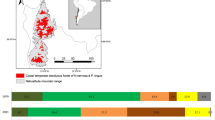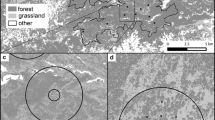Abstract
Habitat losses occur non-randomly within human-modified landscapes, resulting in high spatial heterogeneity of local habitat histories. Although local habitat history can modulate the existence of extinction debt (i.e., the number of populations predicted to become extinct) in a landscape, its role in detecting extinction debt has not been examined explicitly. We aimed to compare the detectability of extinction debt among populations of an endangered semi-natural grassland species, Echinops setifer (Compositae), in the grassland landscape of Mt. Aso, Japan. We classified populations into three groups that differed in local habitat history: stable (habitat loss ≤30% since the 1930s), moderately decreased (30% < loss ≤ 90%), and severely decreased (loss >90%). We then evaluated whether the effects of habitat areas during the 1930s and 2000s varied among groups to explain population size by GLMMs and estimated coefficient of explanatory variable by Bayesian MCMC methods. Within the groups, stable group showed significant positive relationships with both past and current habitat areas. The moderately decreased group only showed significant positive relationships with past habitat areas, indicating the existence of extinction debt in these populations. The severely decreased group only showed significant positive relationships with current habitat areas, indicating that they may have already paid their extinction debt because the rate of grassland loss exceeded the extinction threshold. Even within the same landscape, extinction debt varied in response to local habitat history. In spatially heterogeneous landscapes, evaluation of effects of local habitat history can elucidate the habitat-based extinction risks for plant populations.



Similar content being viewed by others

References
Adriaens D, Honnay O, Hermy M (2006) No evidence of a plant extinction debt in highly fragmented calcareous grasslands in Belgium. Biol Conserv 133:212–224
Akasaka M, Takamura N, Mitsuhashi H, Kadono Y (2010) Effects of land use on aquatic macrophyte diversity and water quality of ponds. Freshw Biol 55:909–922
Baeten L, Hermy M, Van Daele S, Verheyen K (2010) Unexpected understorey community development after 30 years in ancient and post-agricultural forests. J Ecol 98:1447–1453
Barnosky AD, Matzke N, Tomiya S, Wogan GOU, Swartz B, Quental TB, Marshall C, McGuire JL, Lindsey EL, Maguire KC, Mersey B, Ferrer EA (2011) Has the Earth’s sixth mass extinction already arrived? Nature 471:51–57
Brooks SP, Gelman A (1998) General methods for monitoring convergence of iterative simulations. J Comput Graph Stat 7:434–455
Bulman CR, Wilson RJ, Holt AR, Bravo LG, Early RI, Warren MS, Thomas CD (2007) Minimum viable metapopulation size, extinction debt, and the conservation of a declining species. Ecol Appl 17:1460–1473
Cousins SAO (2006) Plant species richness in midfield islets and road verges—The effect of landscape fragmentation. Biol Conserv 127:500–509
Cousins SAO (2009) Extinction debt in fragmented grasslands: paid or not? J Veg Sci 20:3–7
Cousins SAO, Vanhoenacker D (2011) Detection of extinction debt depends on scale and specialisation. Biol Conserv 144:782–787
Cousins SAO, Lavorel S, Davies I (2003) Modelling the effects of landscape pattern and grazing regimes on the persistence of plant species with high conservation value in grasslands in south-eastern Sweden. Landsc Ecol 18:315–332
Cristofoli S, Monty A, Mahy G (2010) Historical landscape structure affects plant species richness in wet heathlands with complex landscape dynamics. Landsc Urban Plan 98:92–98
Eriksson O (1996) Regional dynamics of plants: a review of evidence for remnant, source-sink and metapopulations. Oikos 77:248–258
Ewers RM, Didham RK, Pearse WD, Lefebvre V, Rosa IMD, Carreiras JMB, Lucas RM, Reuman DC (2013) Using landscape history to predict biodiversity patterns in fragmented landscapes. Ecol Lett 16:1221–1233
Foster D, Swanson F, Aber J, Burke I, Brokaw N, Tilman D, Knapp A (2003) The importance of land-use legacies to ecology and conservation. Bioscience 53:77–88
Galeuchet DJ, Perret C, Fischer M (2005) Microsatellite variation and structure of 28 populations of the common wetland plant, Lychnis flos-cuculi L., in a fragmented landscape. Mol Ecol 14:991–1000
Guardiola M, Pino J, Rodà F (2013) Patch history and spatial scale modulate local plant extinction and extinction debt in habitat patches. Divers Distrib 19:825–833
Helm A, Hanski I, Pärtel M (2006) Slow response of plant species richness to habitat loss and fragmentation. Ecol Lett 9:72–77
Hylander K, Ehrlén J (2013) The mechanisms causing extinction debts. Trends Ecol Evol 28:341–346
Jackson ST, Sax DF (2010) Balancing biodiversity in a changing environment: extinction debt, immigration credit and species turnover. Trends Ecol Evol 25:153–160
Japan Meteorological Agency (2011) Monthly data in an average year (1971–2000) at Mt. Aso and Aso-Otohime Meteorological Station. http://www.data.jma.go.jp/jma/indexe.html
Johansson V, Snäill T, Ranius T (2013) Estimates of connectivity reveal non-equilibrium epiphyte occurrence patterns almost 180 years after habitat decline. Oecologia 172:607–615
Kawano T, Sasaki N, Hayashi T, Takahara H (2012) Grassland and fire history since the late-glacial in northern part of Aso Caldera, central Kyusyu, Japan, inferred from phytolith and charcoal records. Quat Int 254:18–27
Kitamoto N, Honjo M, Ueno S, Takenaka A, Tsumura Y, Washitani I, Ohsawa R (2005) Spatial genetic structure among and within populations of Primula sieboldii growing beside separate streams. Mol Ecol 14:149–157
Koyama A, Koyanagi TF, Akasaka M, Takada M, Okabe K (2016) Combined burning and mowing for restoration of abandoned semi-natural grasslands. Appl Veg Sci. doi:10.1111/avsc.12268
Koyanagi T, Kusumoto Y, Yamamoto S, Okubo S, Iwasaki N, Takeuchi K (2012) Grassland plant functional groups exhibit distinct time-lags in response to historical landscape change. Plant Ecol 213:327–338
Koyanagi T, Kusumoto Y, Hiradate S, Morita S, Yokogawa M, Takahashi Y, Sato C (2013) New method for extracting plant indicators based on their adaptive responses to management practices: application to semi-natural and artificial grassland data. Appl Veg Sci 16:95–109
Kuussaari M, Bommarco R, Heikkinen RK, Helm A, Krauss J, Lindborg R, Ockinger E, Pärtel M, Pino J, Roda F, Stefanescu C, Teder T, Zobel M, Steffan-Dewenter I (2009) Extinction debt: a challenge for biodiversity conservation. Trends Ecol Evol 24:564–571
Lindborg R (2007) Evaluating the distribution of plant life-history traits in relation to current and historical landscape configurations. J Ecol 95:555–564
Lindborg R, Ehrlén J (2002) Evaluating the extinction risk of a perennial herb: demographic data versus historical records. Conserv Biol 16:683–690
Lindborg R, Eriksson O (2004) Historical landscape connectivity affects present plant species diversity. Ecology 85:1840–1845
Lindenmayer DB, Fischer J (2006) Habitat fragmentation and landscape change. Island Press, Washington, DC
Lunt ID, Spooner PG (2005) Using historical ecology to understand patterns of biodiversity in fragmented agricultural landscapes. J Biogeogr 32:1859–1873
McIntyre S, McIvor JG, MacLeod N (2000) Principles for sustainable grazing in eucalypt woodlands: landscape-scale indicators and the search for thresholds. In: Hale P, Petrie A, Moloney D, Sattler P (eds) Management for sustainable ecosystems centre for conservation biology. The University of Queensland, Brisbane, pp 92–100
Ministry of the Environment (2014) Red data book for vascular plants (revised). Japan Wildlife Research Center, Tokyo
Öster M, Cousins SAO, Eriksson O (2007) Size and heterogeneity rather than landscape context determine plant species richness in semi-natural grasslands. J Veg Sci 18:859–868
Otaki N (1991) Investigation about roots of Echinops setifer. Botany 41:66–70 (in Japanese)
Pimm SL, Russell GJ, Gittleman JL, Brooks TM (1995) The future of biodiversity. Science 269:347–350
Plummer M (2003). JAGS: a program for analysis of Bayesian graphical models using Gibbs sampling. In: Proceedings of the 3rd international workshop on distributed statistical computing (DSC 2003), Vienna, Austria
R Development Core Team (2015) R: a language and environment for statistical computing. R Foundation for Statistical Computing, Vienna, Austria. http://www.R-project.org
Saar L, Takkis K, Pärtel M, Helm A (2012) Which plant traits predict species loss in calcareous grasslands with extinction debt? Divers Distrib 18:808–817
Saito M, Furukawa T, Koyanagi FT (2016) Time-delayed response of Japanese hare distribution to landscape change along an urban gradient. J Mammal 97:1451–1460
Sawada M (1999) ROOKCASE: an Excel 97/2000 Visual Basic (VB) add-in for exploring global and local spatial autocorrelation. Bull Ecol Soc Am 80:231–234
Soga M, Koike S (2013) Mapping the potential extinction debt of butterflies in a modern city: implications for conservation priorities in urban landscapes. Anim Conserv 16:1–11
Spiegelhalter D, Best N, Carlin B, van der Linde A (2002) Bayesian measures of model complexity and fit. J R Stat Soc B 64:583–639
Su Y, Yajima M (2012) R2jags: A Package for Running jags from R. R package
Tilman D, May RM, Lehman CL, Nowak MA (1994) Habitat destruction and the extinction debt. Nature 371:65–66
United States Geological Survey (2016) M 7.0—1 km E of Kumamoto-shi, Japan. http://earthquake.usgs.gov/earthquakes/eventpage/us20005iis#executive
Vellend M, Verheyen K, Jacquemyn H, Kolb A, Van Calster H, Peterken G, Hermy M (2006) Extinction debt of forest plants persists for more than a century following habitat fragmentation. Ecology 87:542–548
Verheyen K, Honnay O, Motzkin G, Hermy M, Foster DR (2003) Response of forest plant species to land-use change: a life-history trait-based approach. J Ecol 91:563–577
Yamasaki T, Ozeki K, Fujii N, Takehara M, Yokogawa M, Kaneko S, Isagi Y (2013) Genetic diversity and structure of silene kiusiana (Caryophyllaceae) in the Aso Region, Kyushu, Japan, revealed by novel nuclear microsatellite markers. Acta Phytotax Geobot 63:107–120
Yokogawa M, Kaneko S, Takahashi Y, Isagi Y (2013) Genetic consequences of rapid population decline and restoration of the critically endangered herb Polemonium kiushianum. Biol Conserv 157:401–408
Acknowledgements
We greatly appreciate the assistance of three local professionals, Mr. Sumio Sei (Kumamoto University), Mr. Chiyoshi Sato (Kumamoto Plant Research Station), and Mr. Tsuyoshi Saito (Regional Environmental Planning Inc.), and of the Ministry of the Environment, for allowing us to use the population data for E. setifer. We also thank to Dr. Masashi Yokogawa (Osaka Museum of Natural History) for providing various information on the target grassland species. This research was partly supported by the Environment Research and Technology Development Fund (D-1008 and 1-1401) of the Ministry of the Environment, Japan, and by JSPS KAKENHI Grant Number JP25740048 of the Ministry of Education, Culture, Sports, Science and Technology of Japan.
Author information
Authors and Affiliations
Corresponding author
Additional information
Communicated by Thomas Abeli.
Rights and permissions
About this article
Cite this article
Koyanagi, T.F., Akasaka, M., Oguma, H. et al. Evaluating the local habitat history deepens the understanding of the extinction debt for endangered plant species in semi-natural grasslands. Plant Ecol 218, 725–735 (2017). https://doi.org/10.1007/s11258-017-0724-z
Received:
Accepted:
Published:
Issue Date:
DOI: https://doi.org/10.1007/s11258-017-0724-z



